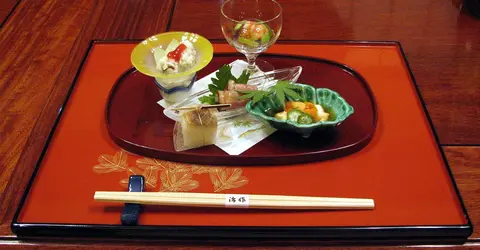Japanese Food and Drink
La cuisine japonaise : recettes, restaurants et conseils pour bien manger japonais
Pour pouvoir choisir, il faut comprendre. Que ce soit au restaurant ou dans une boutique, ne pas connaître le sens d'un mot ou d'une expression peut rapidement stopper votre aventure culinaire. Voici donc quelques notions essentielles pour profiter pleinement de vos repas en toute tranquillité. Et au Japon, il y a de nombreuses choses à découvrir.
How to discover Japanese cuisine?
The cuisine of a country is a vast subject ... Summing up Japanese cuisine would be like trying to tell the whole story of Japan on one page. But if it is essential to immerse yourself in the culture of the country to soak up the tastes, flavors, colors of its dishes, it is still possible to explore some key concepts to open the doors of Japanese cuisine.
Outline of the history of Japanese cuisine
Japanese cuisine as we know it today is an ancient mixture of Chinese and Korean cuisine adapted to incorporate local ingredients of Japan, then gradually influenced by the introduction of other world cuisines.
For more than two millennia, the cuisines of Japan - originally very local due to its fragmented geography - have incorporated elements imported from China: Chinese noodles and soy sauce in particular, as well as Buddhist vegetarian cuisine. The latter, called shojin ryori, has spread widely in Japan but was originally introduced by monks from China. Over the centuries, Japan has thus developed its own traditional cuisine, called washoku.
- Read: Soybeans
Meanwhile, China of course continued to follow its own culinary evolution, and in the Meiji era, a period marked by the political and economic opening of the country, Chinese influences began to creep into Japanese cuisine, and they are not the only ones. Recipes from Western countries also influenced Japanese meals.
During the 20th century, a major policy of standardization and "modernization" of food practices was launched by the Japanese government: it aimed to push the Japanese to enrich their diet with proteins (meat, eggs, dairy products) but also to diversify basic cereals. However, rice is still present in the vast majority of Japanese meals today (when you don't eat noodles), even in dishes inherited from Western cuisine such as tonkatsu, breaded pork cutlet similar to Milanese cutlet.
- Read more: Rice in Japan

Shrimp Sushi from Sukiyabashi Jiro Restaurant in Tokyo
City Foodsters
Traditional Japanese meals
As we have just said, rice is the basis of the traditional Japanese meal. The bowl of rice is usually accompanied by a soup (often a miso soup), and one to three side dishes - this composition is called ichiju sansai (the rule of three plates). However, this is the family meal taken at home and when you eat out, you sometimes order a single dish: a noodle soup (ramen or udon), gyoza, or local specialties such as okonomiyaki from Osaka, Kyoto or Hiroshima, which constitute a complete meal on their own, both in terms of quantity and ingredients.
The meal is usually accompanied by tea, but in the restaurant, freshwater will also be served.
The Japanese eat three times a day. Breakfast is often considered a full-fledged meal. It is therefore not uncommon to eat a bowl of rice and three side dishes following the sansai ichiju. At noon, the meal is often eaten from a bento, which is to say in a practical box to take with you to work and which can be compartmentalized to properly separate the food. The Japanese are the kings of the lunchbox! In the evening, the meal is rather traditional - if you do not go out in an izakaya, in which you would have tempura or yakisoba until you are full.
- See: The Art of Bento
Basics in Japanese Cuisine
Japan’s geography and very diverse climates make staple foods very varied from region to region. Of course, we will often find a common base (rice, round and generally prepared with vinegar, and noodles in particular), which will be adapted according to the regions. Noodles are usually made from wheat or buckwheat.
We eat very few fresh vegetables or raw vegetables in restaurants in Japan. Vegetables will often be served marinated in brine, as an accompaniment to rice: turnip, yellow radish, etc. However, they have always been present in Japanese family cuisine, and have always been so. Potatoes, sweet potatoes and beans, radishes, mushrooms, white cabbage and Chinese cabbage to name a few, are the basis of many dishes. Of course, we should not forget either soy and seaweed, which are very common in Japanese cuisine, starting with the tofu and wakame seaweed found in miso soup.
Regional specialties
Each region then has its specialties of meat, fish, crustaceans ... Of course, the coastal regions and the islands are the most suitable places to eat seafood. But let's mention some of the somewhat special sushi preparations fugu sushi, poisonous pufferfish, a specialty of Osaka. Among meat, there is, of course, the most famous beef - Kobe Waygu. In short, Japan lacks nothing in terms of quality ingredients.
Fermentation is the basis of many ingredients in Japanese cuisine if only through the preparation of miso, a fermented soybean paste found in most dishes - because it gives them flavor. One can also cite among the fermented foods natto (soybeans left whole, fermented, with a very strong taste - it is said that only the real Japanese can bear the taste).
- Read more: Natto

La kaiseki ryôri est l'une des cuisines gastronomiques du Japon
Chris 73
The main cooking techniques
The cooking techniques of Japanese cuisine can be divided into five main categories:
- Yakimono - Sautéed or grilled dishes (yaki), the best-known example of which will be yakisoba (noodles sautéed with vegetables and meat or shellfish depending on the region). Okonomiyaki is also a good example.
- Agemono - Fried food in breadcrumbs, such as tempura.
- Suimono - Soups, broths and boiled foods. We will, of course, mention the miso soup, but also all the noodle soups, or the boiled gyozas (sui gyoza).
- Raw foods, especially fish and seafood that are the basis of sushi.
- Tsukemono - Brine dishes, which are usually used as a side dish, such as small umeboshi sour plums, sometimes served inside rice dumplings (onigiri) to give flavor!
Umami, the 5th flavor
Japanese dishes are very famous for having the quality of umami, which can only be translated as "tasty", and corresponds to the fifth flavor that we are able to perceive, in addition to sweet, salty, sour and bitter. This flavor is obtained in particular thanks to the combination of ingredients capable of producing glutamates and a certain type of nucleotides, which, when it comes into contact with our tongue, trigger an appetizing sensation.
Among the ingredients that produce umami are dashi broth (made from seaweed and dried bonito), mushrooms, shellfish, but also green tea and Chinese cabbage.

Préparation du tonkatsu
Kaiseki Ryôri, Japanese gourmet cuisine
Like any great culinary culture, Japan of course has its gastronomic cuisines, the most widespread of which is inherited from the ancient cuisine of merchants and artists: kaiseki ryori. The other two gourmet cuisines are that of the Heian nobility, known as yusoku, and that of the samurai, honzen.
Kaiseki ryori is a traditional meal consisting of many different dishes served individually in small dishes. In addition to the refinement of the cuisine itself, this gourmet cuisine is based on a skillful balance between tastes, textures, colors, but also shapes of the dishes. The service must of course also be refined, thanks to the traditional Japanese dishes, particularly beautiful, which then takes all its importance. These gourmet meals can last a very long time since you sometimes have to savor more than a dozen dishes!
Ten Must-Try Japanese Dishes
Finally, the best way to discover Japanese cuisine is, of course, to taste it. Here is a non-exhaustive list of some common dishes in Japan, where to start when you are new to the subject:
- Miso Soup
- Noodle soup: ramen, udon or soba
- Tofu, whether fresh or fried, in shojin ryori if possible
- Sushi
- Gyoza, that you can taste grilled, fried or boiled
- Tonkatsu
- Okonomiyaki, a Kansai speciality.
- Unagidon, grilled caramelized eel on a bowl of rice
- Yakitori, grilled skewers
- Wagashi, traditional Japanese sweets


























